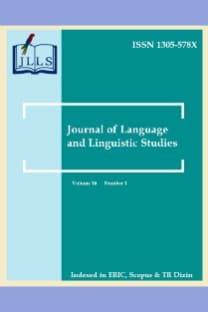Using rubrics as an instructional tool in EFL writing courses
Dereceli Puanlama Cetvelinin (rubric) Yabancı Dil Olarak İngilizce Dersinlerinde Öğretim Aracı Olarak Kullanılması
___
- Andrade, H., & Du, Y. (2005). Student perspectives on rubric-referenced assessment. Practical Assessment, Research & Evaluation, 10(3), 1-11.
- Andrade, H. G. (2000). What do we mean by results? Using rubrics to promote thinking and learning. Educational Leadership, 57(5), 13-18.
- Arter, J. (2000). Rubrics, scoring guides and performance criteria: Classroom tools for assessing and improving student learning. Retrieved from http://www.eric.ed.gov/PDFS/ED446100.pdf
- Bangert-Drowns, R., Kulik C., Kulik, J., & Morgan, M. (1991). The instructional effect of feedback in test-like events. Review of Educational Research, 61, 213-238.
- Bansilal, S., James, A., & Naidoo, M. (2010). Whose voice matters? LEARNERS. South African Journal of Education, 30(1), 153-165.
- Birky, B. (2012). A good solution for assessment. Strategies: A Journal for Physical and Sport Educators, 25, 19-21.
- Butler, D. & Winne, P. (1995). Feedback and self-regulated learning: A theoretical synthesis. Review of Educational Research, 65(3), 245-281.
- Carstens, A. (2001). Generic versus discipline-specific writing interventions: Report on a quasi- experiment. Southern African Linguistics and Applied Language Studies, 29(2), 149-165.
- Chase, C. (1999). Contemporary assessment for educators. New York: Longman.
- Diab, R., & Balaa, L.(2011). Developing detailed rubrics for assessing critique writing: Impact on EFL university students' performance and attitudes. TESOL Journal, 2, 52-72.
- Hillocks, G., Jr. (1986). Research on written composition: New directions for teaching. Urbana, IL: ERIC Clearinghouse on Reading and Communication Skills and the National Conference on Research in English.
- Jacobs, H., Zinkgraf, S.A., Wormuth, D.R., Hartfiel, V.F., & Hughey, J. B. (1981). Testing ESL composition: A practical approach. London: Newbury.
- Kayaoğlu, M. N. (2009). Process writing with the internet. Modern English Teacher, 18, 48-50.
- Mertler, C. A. (2001). Designing scoring rubrics for your classroom. Practical Assessment, Research & Evaluation, 7(25). Retrieved from http://www.ericae. net/pare/getvn.asp?v=7&n=25.
- Moskal, B.M. (2000). Scoring rubrics: What, when and how? Practical Assessment, Research & Evaluation, 7(3). Retrieved from http://PAREonline.net/getvn. asp?v=7&n=3.
- Mueller, J. (2006) Why Use Authentic Assessment. In Authentic Assessment Toolbox (chap.2). Retrieved September, 17, 2006. Retrieved from http://jonathan.mueller.faculty.noctrl.edu/ toolbox/ whydoit.htm
- Nitko, A. J. (2001). Educational assessment of students (3rd ed). Upper Saddle River, NJ: Merrill.
- Panadero, E., & Jonsson, A. (2013). The use of scoring rubrics for formative assessment purposes revisited: A review. Educational Research Review, 9, 129-144.
- Saxton, E., Belanger, S., & Becker, W.(2012). The critical thinking analytic rubric (ctar): Investigating intra-rater and inter-rater reliability of a scoring mechanism for critical thinking performance assessments. Assessing Writing, 17, 251-270.
- Soles, D. (2001). Sharing scoring guides. Retrieved from http://www.eric.ed.gov/ PDFS/ED450379.pdf
- Stears, M., & Gopal, N. (2010). Exploring alternative assessment strategies in science classrooms. South African Journal of Education, 30, 591-604.
- Uys, M., Van der Walt, J., Van den Berg, R., & Botha, S. (2007). English medium of instruction: A situation analysis. South African Journal of Education, 27(1), 69-82.
- Wesolowski, B. C. (2012).Understanding and developing rubrics for music performance assessment. Music Educators Journal, 98, 36-42.
- Wyngaard, S., & Gehrke, R. (1996). Responding to audience: Using rubrics to teach and assess writing. The English Journal. 85, 67-70.
- Zhao, C. G. (2012). Measuring authorial voice strength in L2 argumentative writing: The development and validation of an analytic rubric. Language Testing, 30, 201-230.
- ISSN: 1305-578X
- Yayın Aralığı: 4
- Başlangıç: 2005
- Yayıncı: http://www.jlls.org
Javad GHOLAMİ, Mitra GHOLİZADEH
Using rubrics as an instructional tool in EFL writing courses
Fehmi TURGUTA, M Naci KAYAOĞLUA
The Turkish aorist and progressive: Present tense, future tense, or what?
Şerife DEMİRCİOĞLU, Cemal ÇAKIR
Looking into burnout levels among English language instructors
Eda DEMİREL ERCAN, Paşa Tevfik CEPHE
Teachers of Turkish grammar in the eyes of high school students1
İsmail Hakkı ERTEN, Nesrin ERTEN BAYRAKTAR
Graphic novels: An alternative approach to teach English as a foreign language1
